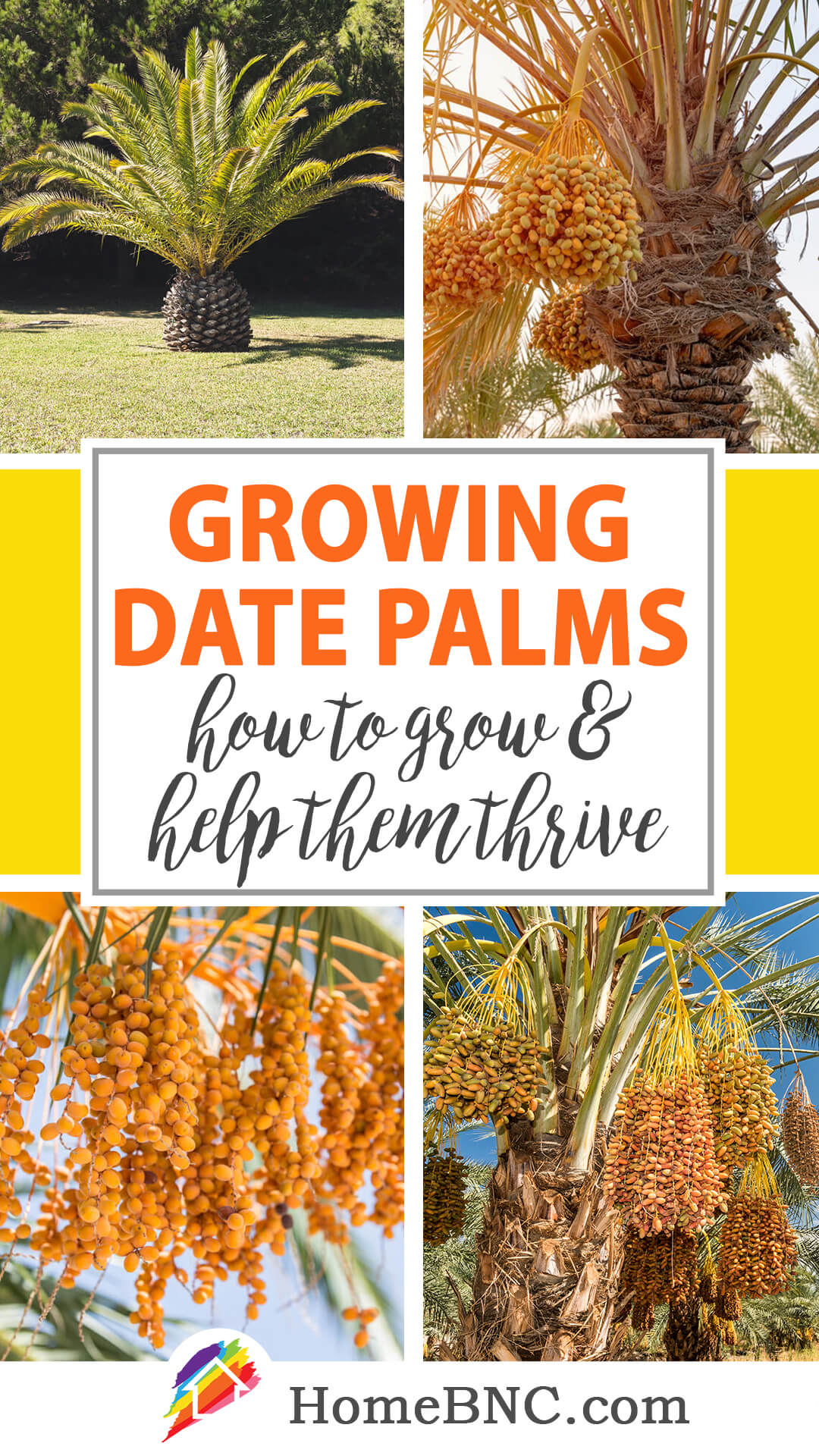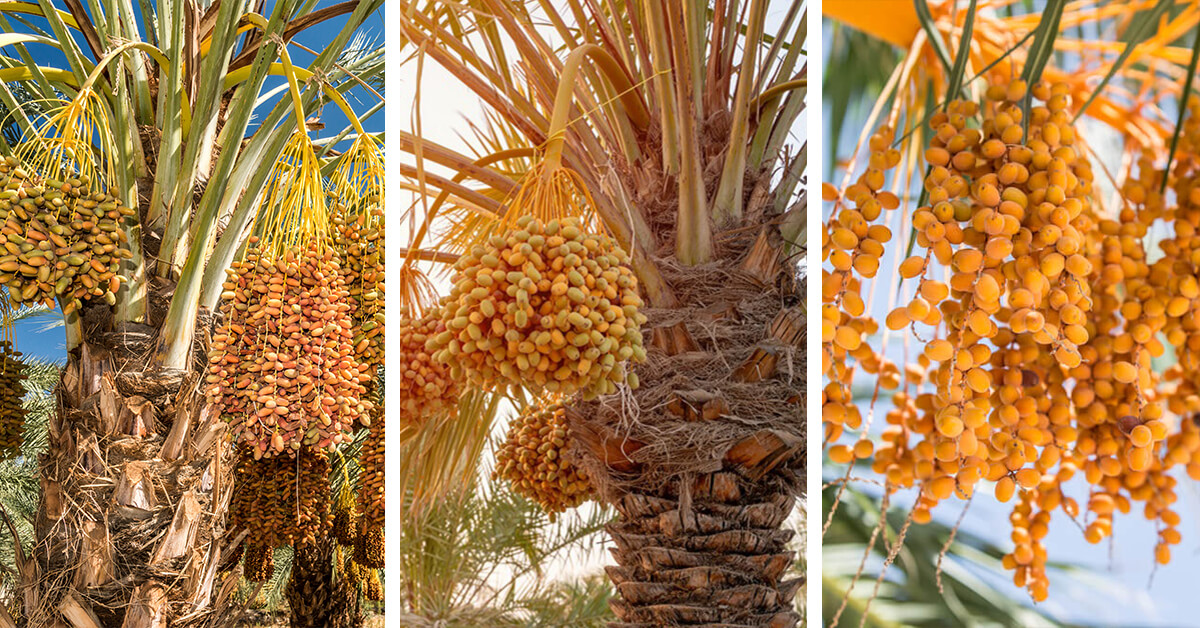Shining 16-long leaves flowering in the sun. Beyond its loveliness as a backspace to your yard, growing Date Palm Trees outdoors can yield sweet, tender fruit. It isn’t hard to cultivate this tree outdoors, and it isn’t difficult if you learn the basics of date palm tree care. As you plant your palm, you can smile, knowing it will help prevent erosion, protecting fertile soil from going the way of storms.
Out on a Date
Most people, when they think of date palms, envision the drupes they yield and eventually end up in the supermarket. But the Date Palm is not just another pretty face… um, tree. Date palms have economic value. For example, the trunk goes into furniture making.
Uses for the Date Palm Tree
Here are some more ways in which this tree yields useful items with processing:
- Date Palm yields salad makings once cut down (heart of palm)
- Fiber turns into packing material, roofing, and cords
- Fruit derivatives include alcohol, syrup, and vinegar
- Leaf bases become fuel
- Leaf midribs are suitable for basketry
- Seeds become stock feed in ground form
- The fruit stocks become rope and fuel
Because of its multifaceted applications, Date Palms cover 3% of cultivated land around the world.
Key Takeaways
- While not as commonly known, the Hawaii Date Palm makes a desirable addition to yards.
- The fruit of the date palm has a plethora of healthy vitamins, minerals, amino acids, and antioxidants.
- Date Palm Trees are drought tolerant. An established tree needs even watering during flower and fruit season, however.
- If you live in a region where the temperature regularly slips below 20F, the Date Palm isn’t a good contender for your landscaping.
8 Cues and Clues for Growing Outdoor Date Palm Trees
1. Varieties of Date Palm Trees
Date Palms are one of the oldest fruit trees that became an important source of food. There are over 1500 types of date palms (whew!).
The deglet noor date palm: Besides being outdoors, this palm often appears in large shopping centers. It provides ambiance against sometimes drab walls. It’s considered the “Queen of Dates.” The fruit is soft, nearly translucent, and tastes like honey.
Pygmy palm date trees: are very well suited for growing indoors and out. They grow slowly and rarely reach 6’ tall. Their flowers come out between September and October, followed by fruit. The clusters hang below the leaves, measuring ½” long. When ripe. The Pygmy Date turns dark purple or reddish-brown.
Medjool date palms: have a reputation for being hardy. It fruits up to three times a year. It is a well-known cold hardy palm tree, fruiting two to three times a year. It bears the alternative name of “Feather Palm” because of its full, dense, silvery-green canopy. Their fruit is long, looking a bit like a finger.
Phoenix dactylifera family: yields incredible sweet fruits. Full grown they tower overhead at 100 in the sky. Because of their slow growth, this family of palms lives to be 100 years under the right conditions.
Mazari palms: look more like shrubs than what we normally think of as palms. They have fan-shaped leaves with no crowns. They produce beautiful clusters of white flowers with a 3-foot stem. The fruits are small and orange.
Zahidis: Perhaps the most popular palm. It lines avenues or stands alone. Perhaps that is why Zahidis means nobility. These are real show-stoppers. They grow 70 feet upward at a slow pace. These palms bear golden fruit with a nutty, sweet flavor.
The United Aram Emirates (UAE) grows more date palms than anywhere else in the world. The count is approximately 40 million trees, 200 cultivars, and 68 commercial. As of 2021, the export value of dates from the UAE was nearly 323 million (USD).
2. Types of Dates (the Fruit)
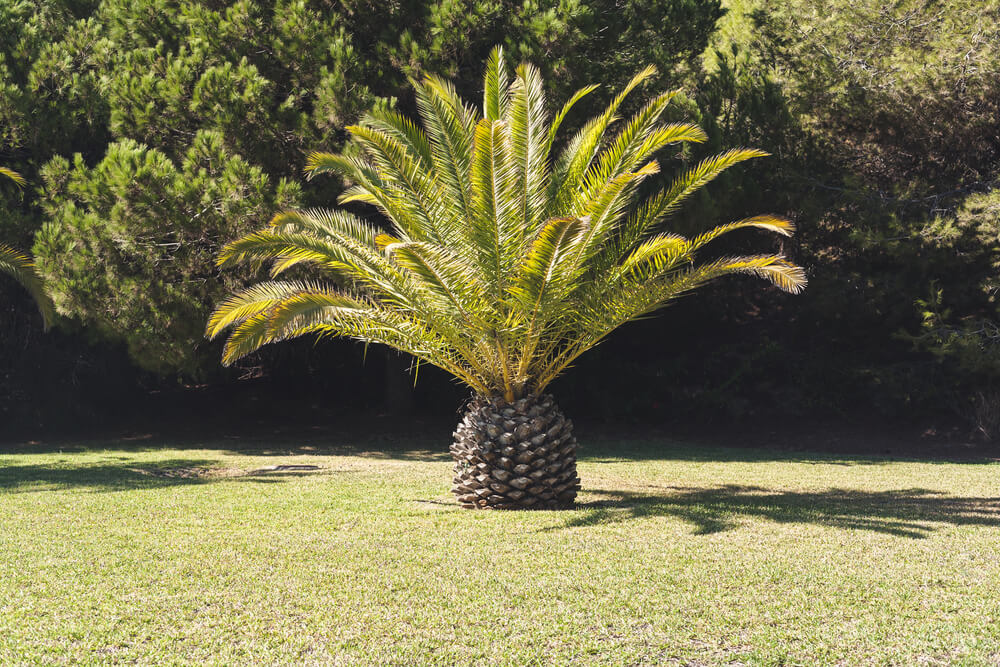
There is no question the world has a passion for dates, consuming approximately 974 metric tons in 2020 (growing by 100 metric tons compared to 2019). But not all dates are created equal. Knowing the type of dates you may get from your Date Palm Tree can influence your choice when buying.
- Barhi: A springy date, petite in size with a syrupy taste. Barhi dates are among the sweetest in the world. It’s unique in that you can consume these while they are still hard. It’s a nice textural crunch.
- Halawy: Delightfully tender fruit with golden brown skin. The name Halawy means “Sweet.”
- Hawaii Dates: These are soft, medium size, and taste like honey and caramel combined (yum!).
- Medjool: A soft fruit about 3” long. Nicknamed the King of Dates.
- Piarom: Dark brown skin with a unique coffee undertone.
- Rabbi: Popular snacking date. Reddish-black meaty skin. An elusive flavor.
- Sweet Sayer Dates: Stand out because you can pit them easily, then stuff them as you wish (try cream cheese, honey, and walnuts)
- Thoory: Dryish with a hint of nuts. Oblong shape with golden-brown fruit.
- Zahidi: A medium-sized date, high on the sweet side. The trees look majestic, and the fruit just adds to the appeal.
There are, of course, many more dates that you may enjoy, including Deglet Noor, Sukkary, Safawi, and Khudn.
Fully grown Date Palms sometimes grow upwards of 100 feet. They fruit after four to five years. And, it’s a tree that keeps on giving. It may live 150 years, producing about 300 pounds of dates annually.
3. Hale, Hardy, and Wholesome
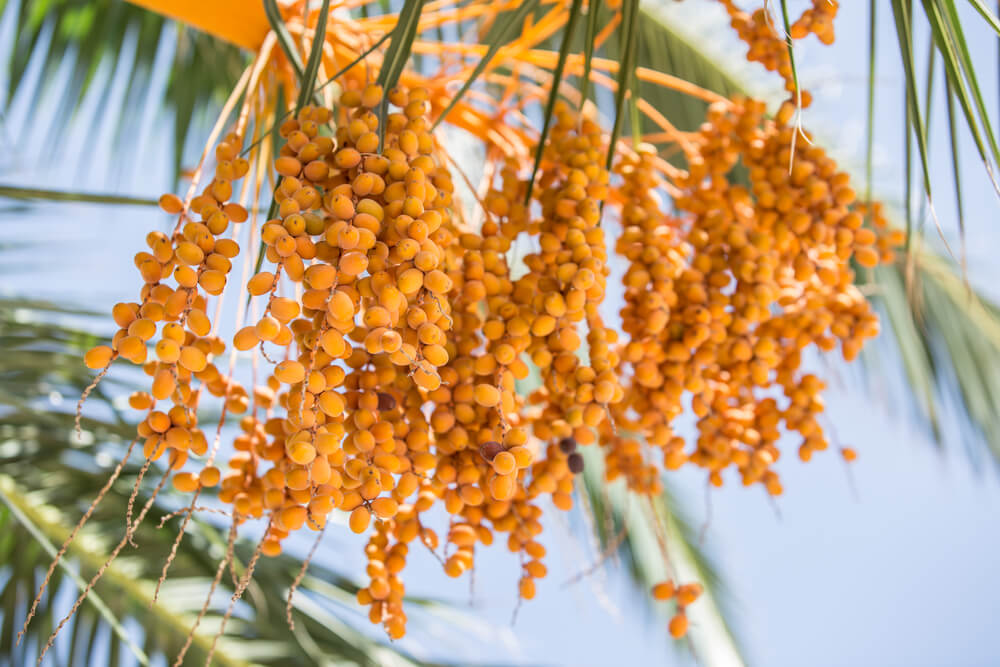
If you are looking for an excellent excuse to grow a date palm tree when talking about the “crazy” idea to your family, you can honestly tell them the fruit is very nutritious. The makeup of dates includes 20 different amino acids for digestion. The fruit has more potassium than bananas. In terms of Vitamins, you eat the alphabet: A, A1, B1, B2, B5, and B6. They also provide protein, copper, and manganese.
Dates have no fat. In Islamic regions, healers use dates to treat respiratory disorders and increase heart rate (fast energy). Some observations imply that dates may stave off heart disease and cancer.
People have been cultivating Date Palm Trees for at least 6,000 years. The fruit holds special significance to Muslims. They not only give dates to infants as a ritualistic first meal, but it also has a place during Ramadan where people fast from sunrise to sunset. Muslims often break their fast with milk and dates or water and dates.
4. Know Before You Grow
Date Palm Trees cannot grow everywhere outdoors. They thrive in warmth. The USDA hardiness zones 8-11 are where date palms develop the best. Even in ideal locations, your palm takes up to four years to reach maturity. If you keep them in well-drained soil, blossoms come in late winter or early spring.
Well-managed date palms should be spaced 30 feet apart. If you live in an area where water sources regularly deplete, you may have problems with salinity levels. The more salt, the less fruit your tree yields. You can offset this somewhat by using high-pH soil and organic fertilizers.
Depending on how large the palm is, you can pay over $800 for a tall tree. During the establishment period, they require substantial amounts of water, so think about how to get it to the tree. Maintaining good care may sometimes require professional assistance, especially for trimming.
Sadly, date palms do not add value to your home for resale.
In 21 BCE, date palms became part of the temple to the Moon Goddess, Nanna. The fronds appeared in construction remains. The Mesoptamians were making fired brick platforms called ziggurats. One of the best preserved is the Ziggurat at UR. Her standing place was at the top of the 30-meter-tall building.
5. When to Plant Date Palm Trees
The best time to plant your palm is during the early spring or fall. Make sure you pick a location with plenty of space for the tree. It will need lots of sun and excellent soil drainage. Younger palms are suitable for container growth, too.
Dig your hole a little deeper than the Date’s root ball. Make sure it’s twice as wide for the root ball, too. Look around and remember a mature plant can take up 40 feet of space. So, think about where you’re putting other plants.
Once you have a mature tree, it takes about 200 days from pollination to flowering. The fruit takes around six months for full ripening. It grows in four stages. First is Kimir. The dates are hard and green. This is the longest stage in the date’s life.
Next comes the Khalal stage. During the next five weeks, the fruit’s color begins changing. Some brave people eat dates now, but it’s not recommended.
In the Rutab stage, the fruit is suitable for selling and eating. Most people experience Rutab in their Date selections. These are, however, delicate so handle with care.
Finally comes the Tamr stage. Most dates are harvested now.
6. Care and Keeping of Date Palm Trees Outdoors
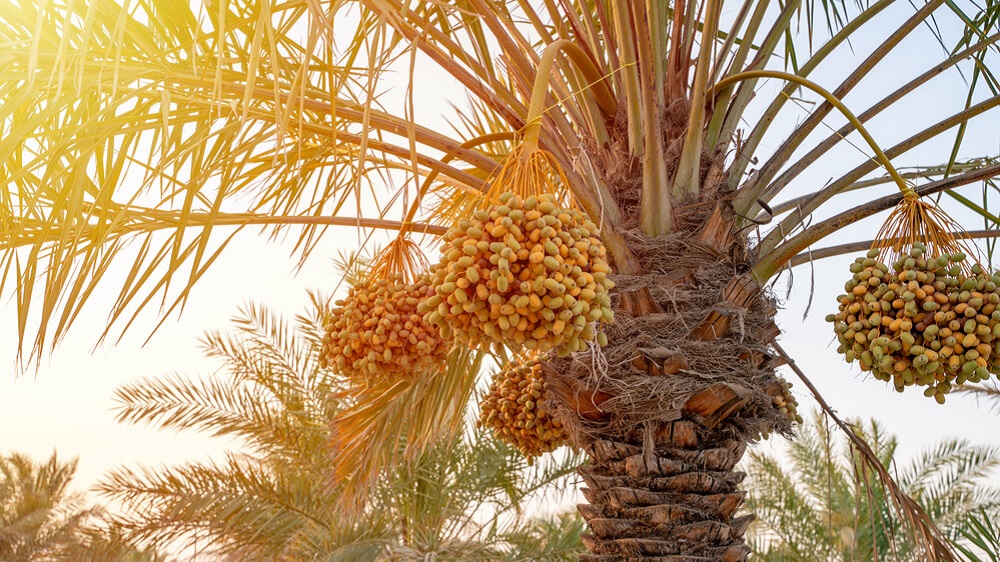
There are six points to caring for date palms. First comes light. If the palm date had a favorite song, it would be “Here Comes the Sun!” A little shade is okay, so long as the plant receives at least 6 hours of direct sunlight daily.
Remaining Necessities for Healthy Date Palms
- Soil: When palms are over-soaked and soggy, it can kill them. You want soil known for good drainage and with a slightly acidic pH.
- Fertilizer: Building on soil, the Date Palm Tree thrives with plain, old manure for fertilizer. Apply in late winter or early spring.
- Temperature: Date palms love it when the temperature sits around 95 °F. It can live through temperatures around 20 °F, but long exposure may damage fronds and even kill the tree.
- Water: Once your date palm is established, it is drought tolerant. But, it will need even moisturizing when it’s flowering and fruiting. The younger palms need more water than the older ones.
- Pollination: Date palms have male and female trees. For pollination, you want one male pam to every six female trees (such a Casanova he is). The wind does the rest of the work.
Sumerians revered the Date Palm. They considered it the Tree of Knowledge, of Good and Evil. The Judean date palm tree represented Judea and fertility. In Hebrew, the date palm is “Tamar,” and it symbolizes grace and sophistication, making it a popular name for female children.
7. Date Palm Tree Pests & Diseases
As mentioned, Date Palm Trees are pretty sturdy in the face of an ever-changing environment. Nonetheless, there are still some things that can affect them. Here are just a few.
Diseases
- Bayoud disease: is characterized by leaf death from the base upward. It is a fungus born in the soil. Sadly a tree experiencing this illness should be destroyed and all remnants taken away from other trees.
- Black Scorch disease; leaves develop hard lesions; Foliage looks scorched. It is caused by a fungus, but you can fight it with pruning, getting all the infected fronds out and destroyed. Treat with fungicide.
- Graphiola leaf spot. Has yellow masses and black lesions on the fronds. Get rid of affected parts, followed by a fungicide treatment.
Pests
- Rhinoceros beetle: the major sign is v-shaped cuts in the leaves. As adults, it is easy to see this large black bug. One thing that helps is swapping out old mulch and composts, a favorite place for egg-laying. When the population is at its peak, a G1 hook can extract them, or there are pheromone traps.
- Parlatoria Date Scale: while it sounds like a disease, it is actually caused by feeding insects. The leaves turn yellow, and the fruits become discolored. Keep pruning your palm and treat it with mineral-based oils.
On the food timeline, dates appear alongside maize and spelt (6000 BC). Chickpeas entered the scene in 5000 BCE. In the first century AD, a recipe for haggis included stuffed dates.
8. Date Palm Tree Facts & Trivia
- Of the date palm, Mohammed said, “There is among the trees, one which is blessed – it is the date palm, for it was created from the earth leftover from the creation of Adam.”
- The Qur’an mentions date palms over 20 times.
- Thousands of years ago, Kings carried palms as an emblem of victory.
- Palm Trees were part of the Prophet’s Mosque, the trunks acting as pillars.
- Palm tree leaves were carried as symbols of victory by kings thousands of years ago.
- In Greek Mythology, the legendary Phoenix built its nest at the top of the Date Palm. From here, the fire of rebirth emerged.
- The ancient Egyptians marked years using images of full date palms. Why? Because it grows 12 fronds a year.
The word date originated in the Greek term daktylos, roughly translated as finger. If you look at a date, it does (indeed) look like a fingertip.
8 Details and Findings for Successfully Growing Date Palm Tree
Growing a date palm tree outdoors isn’t for everyone. But if you’re looking for bold and beautiful, a date palm may just be in your future. As long as you have adequate space, sun, and well-aerated soil, these palms pretty much take care of themselves. Better still, your efforts manifest in sweet, healthy treats, usable in many recipes.
[wp-faq-schema title=”Frequently Asked Questions About Palm Trees Outdoors” accordion=1]